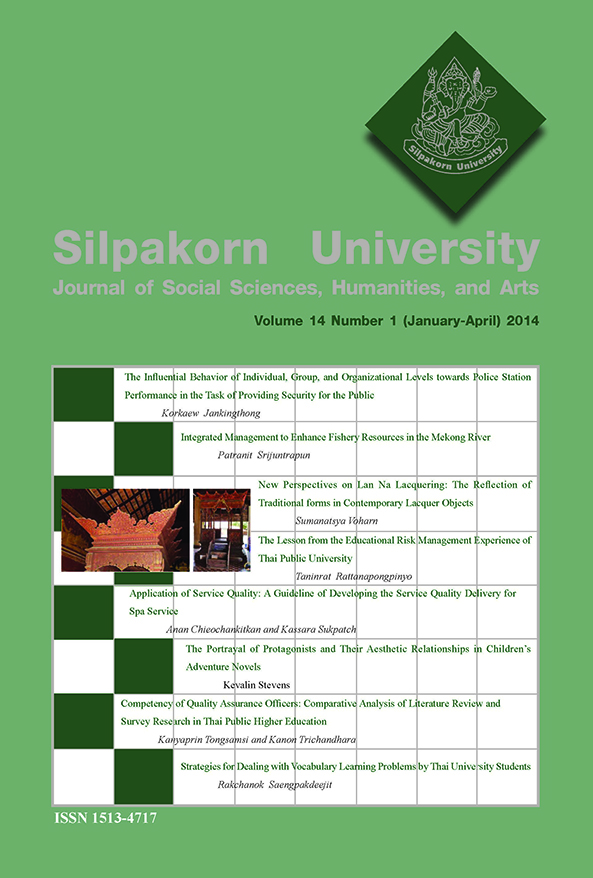The Portrayal of Protagonists and Their Aesthetic Relationships in Children’s Adventure Novels
Main Article Content
Abstract
Traditional criticism of the adventure genre tends to focus only on stereotypical depictions of protagonists’ static identities, their unequal relationships with other characters and the location as a static place the protagonists travel through on their journeys. This research does not discard previous criticism but further analyzes and underscores dynamic and positive nuances that explain these stereotypical depictions in the adventure genre. This research aims to investigate how protagonists develop their identities and their relationships with others in six realistic adventure novels for children published between 2000 through 2010, and which were awarded The Newbery Medal in the United States. It has emphasis on: 1) the portrayal of the protagonists, through the use of Bakhtinian “aesthetic” and undesirable relationships, which the protagonists develop with other characters, and 2) places which help construct or obstruct the dynamic identities of the protagonists in conjunction with their aesthetic relationships. Through the integration of Mikhail Bakhtin’stheory of the Aesthetic Relationship and the interpretive framework of cultural geography, the findings reveal that protagonists socially and spatially construct dynamic identities and develop aesthetic relationships with others within a cultural context as long as a powerful and coercive social hegemony is lax or absent. However, they fail to do so in a cultural context within such rigid social systems.
Downloads
Article Details
All rights reserved. Apart from citations for the purposes of research, private study, or criticism and review,no part of this publication may be reproduced, stored or transmitted in any other form without prior written permission by the publisher.
References
Bakhtin, M. M. (1990) Author and Hero in Aesthetic Activity. In Art and Answerability: Early Philosophical Essays, edited by Holquist, M. and Liapunov, V. (Liapunov, V., trans.), pp. 4-256. Austin: University of Texas Press.
Bereska, T. (2003) The Changing Boys’ World in the 20th Century: Reality and ‘Fiction’. Journal of Men’s Studies 11(2): 157-174.
Brandist, C. (2002) The Bakhtin Circle: Philosophy, Culture and Politics.London: Pluto Press.
Çaliskan, S. (2006) Ethical Aesthetics/Asthetic Ethics: The Case of Bakhtin. Journal of Art and Science 5: 1-8.
Coates, R. (2004) Christianity in Bakhtin: God and the Exciled Author. Cambridge: Cambridge UP.
Crang, M. (1998) Cultural Geography. London: Routledge.
Creech, S. (2000) The Wanderer. New York: Harper Trophy.
Cullingford, C. (1998) Children’s Literature and Its Effects: The Formative Years. London: Cassel.
Curtis, C. P. (2007) Elijah of Buxton. New York: Scholastic.
D’Ammassa, D. (2009) Encyclopedia of Adventure Fiction. New York: Facts On File.
Grenby, M. O. (2008) Children’s Literature. Edinburgh: Edinburgh UP.
Holm, J. L. (2010) Turtle in Paradise. New York: Random House.
Holquist, M. (1990) Dialogism:Bakhtin and His World. London: Routledge.
Hourihan, M. (1997) Deconstructing the Hero: Literary Theory and Children’s Literature. London: Routledge.
Hunt, P. (2001) Children’s Literature. Oxford: Blackwell Pub.
Knowles, M. and Malmkjær, K. (1996) Language and Control in Children’s Literature. London: Routledge.
österlund, M. (2002) Gender and Beyond: Ulf Stark’s Conservative Rebellion. In Children’s Literature as Communication: The ChiLPA Project, edited by Sell, R. D., pp. 177-200. Amsterdam: John Benjamins Pub.
Phillips, R. (1997) Mapping Men and Empire: A Geography of Adventure. London: Routledge.
Pollard, R. (2011) Ethics in Practice: A Critical Appreciation of Mikhail Bakhtin’s Concept of “Outsidedness” in Relation to Responsibility and the Creation of Meaning in Psychotherapy. American Journal of Psychotherapy 65(1): 1-25.
Preus, M. (2010) Heart of a Samurai. New York: Amulet Books.
Schmidt, G. D. (2004) Lizzie Bright and the Buckminster Boy. New York: Laurel-Leaf.
Smith, M. J. (2011) Empire in British Girls’ Literature and Culture: Imperial Girls, 1880-1915. New York: Palgrave Macmillan.
Turner, V. W. (1969) The Ritual Process: Structures and Anti-Structure.Chicago: Aldine Pub.
Van Gennep, A. (1960) The Rites of Passage. (Vizedom, M. B. & Caffee, G. L. trans.) Chicago: University of Chicago Press.
Wannamaker, A. (2008) Boys in Children’s Literature and Popular Cul-ture: Masculinity, Abjection, and the Fictional Child. New York: Routledge.
William-Garcia, R. (2010) One Crazy Summer. New York: Amistad.


